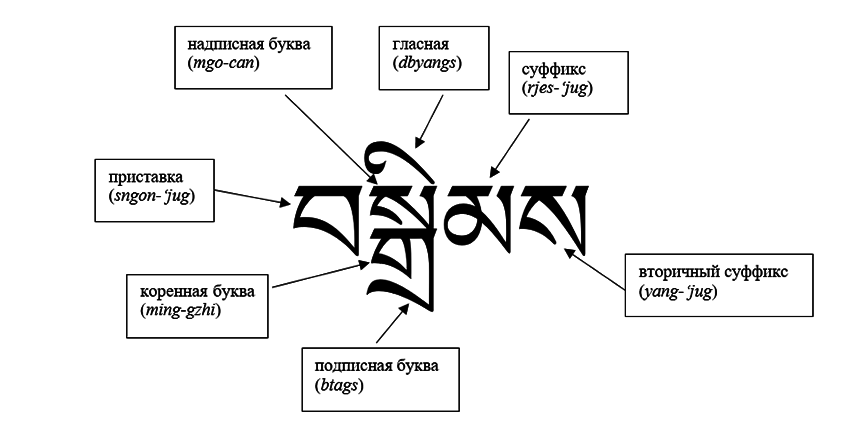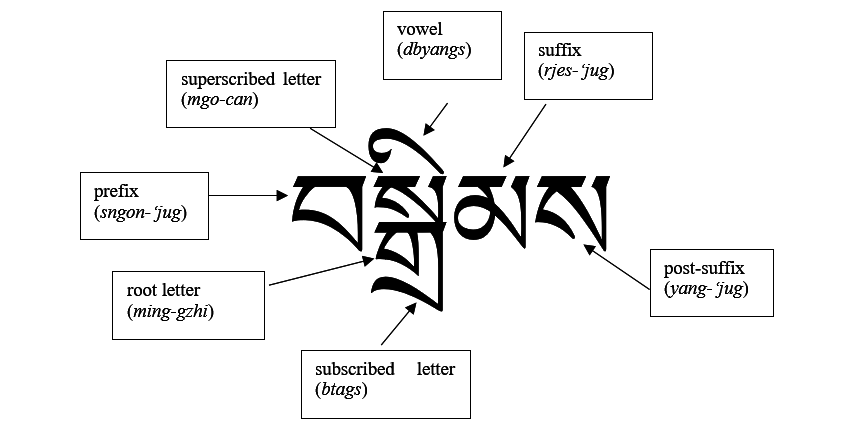Wylie Transliteration Scheme
We will use Extended Wylie Transliteration Scheme (EWTS) in order to provide exact transliteration of Tibetan script for all our projects. Wylie transliteration was designed to precisely transcribe Tibetan script as written, which led to its acceptance in academic and historical studies. It is not intended to represent the pronunciation of Tibetan words.
This transliteration method was refined in 1959 by Turrell Wylie at University of Washington. It has subsequently become a standard transliteration scheme of Tibetan studies, especially in the Western world due to its simplicity (it is using only simple unaccented Roman letters available on a typical English language typewriter) and at the same time, its reliability. It is unambiguous, so that given transliterated letter and/or word cannot be contextually reconstructed back to the original language in two alternative ways.
Wylie's original scheme is not capable of transliterating all Tibetan-script texts. In particular, it has no correspondences for most Tibetan punctuation symbols, and lacks the ability to represent non-Tibetan words written in Tibetan script (Sanskrit and phonetic Chinese are the most common cases). The Tibetan and Himalayan Library at the University of Virginia (Nathaniel Garson and David Germano's "Extended Wylie Trans-literation Scheme" (January 31, 2003 update) developed a standard, Extended Wylie Tibetan System or EWTS, that resolves this problem. It uses capital letters and Latin punctuation to represent the missing characters.
Below one can find the basic principles by which it is easy to convert any Tibetan word into its transliteration and vice versa. For the convenience of readers will be given schemas transliteration by T. Wiley (in bold) and B.-D. Badaraev (in italics). Transliteration by B.-D. Badaraev is based on the same principles as the Wiley transliteration, but using Cyrillic.
The Tibetan Alphabet
ཀ | ཁ | ག | ང |
| ka | kha | ga | nga |
| ка | кха | га | нга |
ཅ | ཆ | ཇ | ཉ |
| ca | cha | ja | nya |
| ча | чха | джа | нйа |
ཏ | ཐ | ད | ན |
| ta | tha | da | na |
| та | тха | да | на |
པ | ཕ | བ | མ |
| pa | pha | ba | ma |
| па | пха | ба | ма |
ཙ | ཚ | ཛ | ཝ |
| tsa | tsha | dza | wa |
| ца | цха | дза | ва |
ཞ | ཟ | འ | ཡ |
| zha | za | ‘a | ya |
| жа | for | ‘a | йа |
ར | ལ | ཤ | ས |
| ra | la | sha | sa |
| ра | ла | ша | са |
ཧ | ཨ | ||
| ha | a | ||
| ха | а |
Vowels
ཨ | ཨི | ཨུ | ཨེ | ཨོ |
| a | i | u | e | o |
| а | and | у | э | о |
Thirty letters of the alphabet can be combined in different ways, forming a composite Tibetan syllable. In writing, each syllable ends with a point called tsheg (tsheg), which function is separation of syllables. In transliteration by B.-D. Badaraev tsheg replaced by a hyphen icon, and in the transliteration by Wiley it replaced by space.
Examples of simple combinations.
ལོ | བུ | རེ་བ | མི |
| lo | bu | re ba | mi |
| ло | бу | рэ-ба | ми |
ཇོ་བོ | དེ | སུ | འོ་མ |
| jo bo | de | su | 'o ma |
| джо-бо | дэ | су | 'о-ма |
Syllable
The entire Tibetan syllable is based on the letter which is called the root letter (ming gzhi). It can be surrounded by other letters. Some of them are written before, above or below, and others after the root letter. Here is an example of a Tibetan syllable contain-ing all possible elements:


ཀྭ | ཁྭ | གྭ | ཉྭ | ཏྭ | དྭ |
| kwa | khwa | gwa | nywa | twa | dwa |
| ква | кхва | гва | нйва | тва | два |
ཚྭ | ཞྭ | ཟྭ | རྭ | ལྭ | ཤྭ |
| tshwa | zhwa | zwa | rwa | lwa | shwa |
| цхва | два | зва | рва | лва | шва |
There are 14 subscribed combinations with ra (ra btags can gyi yi ge)
ཀྲ | ཁྲ | གྲ | ཏྲ | ཐྲ | དྲ | ནྲ |
| kra | khra | gra | tra | thra | dra | nra |
| кра | кхра | гра | тра | тхра | дра | нра |
པྲ | ཕྲ | བྲ | མྲ | ཤྲ | སྲ | ཧྲ |
| pra | phra | bra | mra | shra | sra | hra |
| пра | пхра | бра | мра | шра | сра | хра |
There are 7 subscribed combinations with ya (ya btags can gyi yi ge)
ཀྱ | ཁྱ | གྱ | པྱ | ཕྱ | བྱ | མྱ |
| kya | khya | gya | pya | phya | bya | mya |
| кйа | кхйа | гйа | пйа | пхйа | бйа | мйа |
There are 6 subscribed combinations with la (la btags can gyi yi ge)
ཀླ | གླ | བླ | ཟླ | རླ | སླ |
| kla | gla | bla | zla | rla | sla |
| кла | гла | бла | зла | рла | сла |
There are 12 superscribed combinations with ra (ra mgo can gyi yi ge)
རྐ | རྒ | རྔ | རྗ | རྙ | རྟ |
| rka | rga | rnga | rja | rnya | rta |
| рка | рга | рнга | рджа | гнйа | рта |
རྡ | རྣ | རྦ | རྨ | རྩ | རྫ |
| rda | rna | rba | rma | rtsa | rdza |
| рда | рна | рба | рма | рца | рдза |
There are 10 superscribed combinations with la (la mgo can gyi yi ge)
ལྐ | ལྒ | ལྔ | ལྕ | ལྗ |
| lka | lga | lnga | lca | lja |
| лка | лга | лнга | лча | лжда |
ལྟ | ལྡ | ལྤ | ལྦ | ལྷ |
| lta | lda | lpa | lba | lha |
| лта | лда | лпа | лба | лха |
There are 11 superscribed combinations with sa (sa mgo can gyi yi ge)
སྐ | སྒ | སྔ | སྙ | སྟ | སྡ |
| ska | sga | snga | snya | sta | sda |
| ска | сга | снга | снйа | ста | сда |
སྣ | སྤ | སྦ | སྨ | སྩ | |
| sna | spa | sba | sma | stsa | |
| сна | спа | сба | сма | сца |
The Wylie system does not normally distinguish these prefix, superscripted or subscripted letters as in practice no ambiguity is possible under the rules of Tibetan spelling. The exception is the sequence "gy", which may be written either with a prefix "g" or a suffix "y". In the Wylie system, these are distinguished by inserting a period between a prefix "g" and initial "y". E.g. གྱང "wall" is gyang, while གཡང་ "chasm" is g.yang.
Examples
གཡུ | གཡག | གཡེང | གཡང |
| g.yu | g.yag | g.yeng | g.yang |
| г.йу | г.йаг | г.йэнг | г.уанг |
རྒྱུད | གྱག | གྱེན | གྱང |
| rgyud | gyag | gyen | gyang |
| ргйуд | гйаг | гйэн | гйанг |
Words examples
རེད | རུས་སྦལ | སྐྱེ | བརྒྱང | སྤྱི |
| red | rus sbal | skye | brgyang | spyi |
| рэд | рус-сбал | скйэ | бргйанг | спйи |
གྲྭ་པ | གཡུང | རྡེའུ | བྱུ་རུའང | ཁྱོའི |
| grwa pa | g.yung | rde'u | byu ru'ang | khyo'i |
| грва-па | г.йунг | рдэ'у | бйу-ру'анг | кхйо'и |
Sanskrit
There are several inverted letters used for transliteration of Sanskrit loan words by means of Tibetan script. It is due to the fact that in the alphabet, which Sanskrit is writ-ten, there are some letters that are not in Tibetan. They are transmitted by capital letters in the extended Wylie transliteration system. Long vowels, indicative of Sanskrit words or other foreign influences, are transliterated using the capitals of the respective vow-els. Long vowels are indicated in Tibetan by the presence of a small ‘a (‘a chung), below the root letter stack.
Examples
ཨཱི | ཨཽ | ཀརྨ་པ | ལོ་ཙཱ་བ | དྷརྨ་ཀཱིརྟི |
| I | au | karma pa | lo tsA ba | dharma kIrti |
ཨཱུ | ཨཱཿ | ཨུཏྤལ | པཎ་ཌི་ཏ | པདྨ |
| U | AH | utpal | paN Di ta | Padma |
ཨཻ | ཧཱུྃ | ཀྵ་ཡ | ཤམྦྷལ | ཏདྱཐཱ |
| Ai | hUM | kSha ya | Shambhala | tadyathA |
